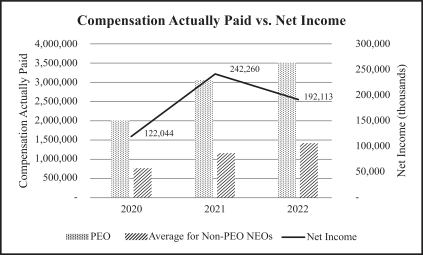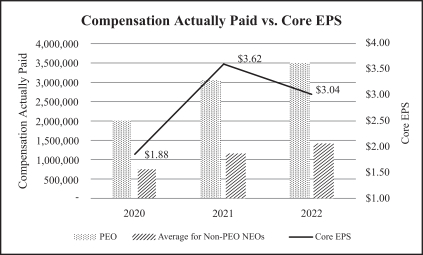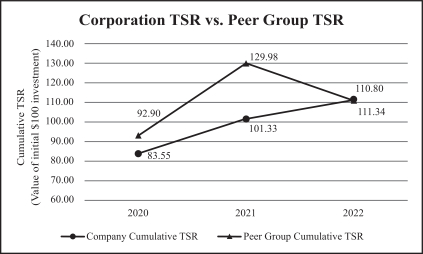Pittsburgh, Pennsylvania from 2008 to 2013, and was Vice President, Human Resources at Three Rivers Aluminum Company (TRACO) in Cranberry, Pennsylvania from 2005 to 2008. He was also formerly with Invesmart, Inc. in Pittsburgh and Federated Investors, Inc. in Pittsburgh.
SCOTT A. LOVE, age 46, is the Executive Vice President, Wealth Management. He formerly served as Executive Vice President, Chief Investment Strategist and Chair of the Chief Investment Office. He has been with the Corporation since 2012 and has more than 20 years of investment research and portfolio management experience. Mr. Love is a Chartered Alternative Investment Analyst and a Chartered Investment Management Analyst. He is a graduate of Baldwin Wallace College and received a master’s degree in Business Administration from Case Western Reserve University.
ROBERT H. FRIEND, age 59, has served as Executive Vice President—Chief Credit Officer since June of 2022. Prior to that, he served as Executive Vice President—Regional Credit Officer. Mr. Friend joined the Corporation in July 2012. He has over 30 years of banking experience in lending, credit and management roles, beginning with PNC Bank in Pittsburgh, Pennsylvania. Mr. Friend began his career in public accounting with Touche Ross & Co. in Cincinnati, Ohio.
JONATHAN D. DARGUSCH, age 63, is currently65, retired as of December 31, 2022, and was formerly Executive Vice President – Wealth Management of the Corporation. Mr. Dargusch joined the Corporation in March 2011 having been previously employed by JPMorgan Chase Bank in Columbus, Ohio. Mr. Dargusch holds FINRA Series 7, 24 and 66 licenses for Ohio and West Virginia and has been in the financial services industry for 3739 years, with over 1921 years as a wealth management executive.
ANTHONY F. PIETRANTON, age 61, is Senior Executive Vice President, Human Resources of the Corporation and the Bank who joined the Corporation on October 16, 2013. Mr. Pietranton has over 33 years’ experience in human resource management and most recently served as Vice President, Human Resources at Tri State Capital Bank in Pittsburgh, Pennsylvania from 2008 to 2013, and was Vice President, Human Resources at Three Rivers Aluminum Company (TRACO) in Cranberry, Pennsylvania from 2005 to 2008. He was also formerly with Invesmart, Inc. in Pittsburgh and Federated Investors, Inc. in Pittsburgh.
IVAN L. BURDINE, age 64, has served as Executive Vice President—Chief Credit Officer since July of 2015. Prior to that, he served as Senior Vice President—Senior Credit Officer. Mr. Burdine, who joined the Corporation in December of 2013, has over 39 years of experience and previously held various credit and executive positions with JP Morgan Chase Bank, NA and its predecessor banks in Columbus and Cleveland, Ohio.
STEPHEN J. LAWRENCE, age 63,65, has served as Executive Vice President & Chief Internal Auditor since May of 2016. Prior to that, he served as Senior Vice President while continuing as Chief Internal Auditor since 2001. He also served as Audit Manager and Regional Bank Operations Manager since joining the Corporation in 1994 through the acquisition of First Fidelity Bancorp, Inc. Mr. Lawrence has more than 3941 years of experience in the banking industry and is a Certified Bank Auditor.
MICHAEL L. PERKINS, age 55, is the Senior Executive Vice President—Chief Risk and Administrative Officer of the Corporation and has served in enterprise risk management responsibilities since 2001. Prior to that, he was Senior Vice President and Chief Auditor of the Corporation. Mr. Perkins has 32 years’ experience in banking, working in the financial services industry as a public accountant prior to joining the Corporation in 1995. Mr. Perkins is a licensed Certified Public Accountant.
BRENT E. RICHMOND, age 57,59, is currently Executive Vice President—Treasury and Strategic Planning of the Corporation. Mr. Richmond served as Executive Vice President—Operations from March 2002, until December, 2003. Mr. Richmond was the President and Chief Operating Officer of American Bancorporation until its merger with the Corporation on March 1, 2002, as well as Chief Executive Officer of Wheeling National Bank. Mr. Richmond previously held the positions of Executive Vice President, Chief Financial Officer and Corporate Secretary of American Bancorporation.
DANIEL K. WEISS, JR., age 39, has servedManagement Succession
The executive officers of the Corporation engage in a formal process of management succession which includes both an annual review and assessment of talent, skills, leadership and diversity in a series of meetings in the spring or early summer, and an assessment of promotability and depth at key positions within the Corporation. This meeting is followed with a formal presentation to the full Board of Directors of key executive officer positions with an assessment of the depth of leadership at each such position, proximity to retirement of key executives and identification of whether the position can be filled internally or externally.
As a part of this process, Mr. Clossin identified a target retirement date and a search was conducted by a committee of Board members designated by the Board of Directors of the Corporation. Both internal candidates and external candidates were interviewed for the position and considered. Upon recommendation of the committee, and upon approval of the Board of Directors, Jeffrey H. Jackson was selected and entered into an employment contract with the Corporation on July 5, 2022. He began employment with the Corporation on August 15, 2022, as Senior Vice President & Chief Accounting Officer since January, 2021 and previously has served as SeniorExecutive Vice President and Corporate Controller, as well as working in various other roles, including Assistant Controller, since joiningChief Operating Officer of the Corporation and President and Chief Operating Officer of the Bank. It is anticipated that he will succeed Mr. Clossin upon his retirement in 2008. PriorJanuary of 2024.
17













































